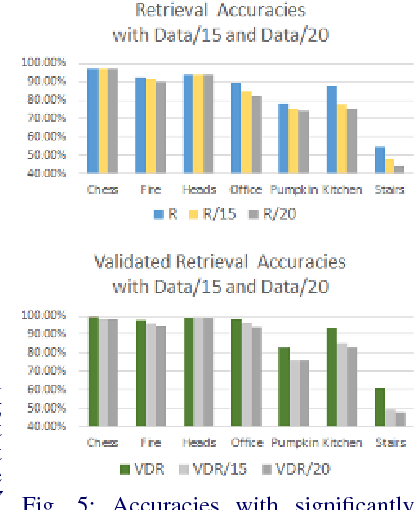Rahul Sawhney
Purely Geometric Scene Association and Retrieval - A Case for Macro Scale 3D Geometry
Aug 03, 2018



Abstract:We address the problems of measuring geometric similarity between 3D scenes, represented through point clouds or range data frames, and associating them. Our approach leverages macro-scale 3D structural geometry - the relative configuration of arbitrary surfaces and relationships among structures that are potentially far apart. We express such discriminative information in a viewpoint-invariant feature space. These are subsequently encoded in a frame-level signature that can be utilized to measure geometric similarity. Such a characterization is robust to noise, incomplete and partially overlapping data besides viewpoint changes. We show how it can be employed to select a diverse set of data frames which have structurally similar content, and how to validate whether views with similar geometric content are from the same scene. The problem is formulated as one of general purpose retrieval from an unannotated, spatio-temporally unordered database. Empirical analysis indicates that the presented approach thoroughly outperforms baselines on depth / range data. Its depth-only performance is competitive with state-of-the-art approaches with RGB or RGB-D inputs, including ones based on deep learning. Experiments show retrieval performance to hold up well with much sparser databases, which is indicative of the approach's robustness. The approach generalized well - it did not require dataset specific training, and scaled up in our experiments. Finally, we also demonstrate how geometrically diverse selection of views can result in richer 3D reconstructions.
Anisotropic Agglomerative Adaptive Mean-Shift
Nov 15, 2014



Abstract:Mean Shift today, is widely used for mode detection and clustering. The technique though, is challenged in practice due to assumptions of isotropicity and homoscedasticity. We present an adaptive Mean Shift methodology that allows for full anisotropic clustering, through unsupervised local bandwidth selection. The bandwidth matrices evolve naturally, adapting locally through agglomeration, and in turn guiding further agglomeration. The online methodology is practical and effecive for low-dimensional feature spaces, preserving better detail and clustering salience. Additionally, conventional Mean Shift either critically depends on a per instance choice of bandwidth, or relies on offline methods which are inflexible and/or again data instance specific. The presented approach, due to its adaptive design, also alleviates this issue - with a default form performing generally well. The methodology though, allows for effective tuning of results.
GASP : Geometric Association with Surface Patches
Nov 15, 2014



Abstract:A fundamental challenge to sensory processing tasks in perception and robotics is the problem of obtaining data associations across views. We present a robust solution for ascertaining potentially dense surface patch (superpixel) associations, requiring just range information. Our approach involves decomposition of a view into regularized surface patches. We represent them as sequences expressing geometry invariantly over their superpixel neighborhoods, as uniquely consistent partial orderings. We match these representations through an optimal sequence comparison metric based on the Damerau-Levenshtein distance - enabling robust association with quadratic complexity (in contrast to hitherto employed joint matching formulations which are NP-complete). The approach is able to perform under wide baselines, heavy rotations, partial overlaps, significant occlusions and sensor noise. The technique does not require any priors -- motion or otherwise, and does not make restrictive assumptions on scene structure and sensor movement. It does not require appearance -- is hence more widely applicable than appearance reliant methods, and invulnerable to related ambiguities such as textureless or aliased content. We present promising qualitative and quantitative results under diverse settings, along with comparatives with popular approaches based on range as well as RGB-D data.
 Add to Chrome
Add to Chrome Add to Firefox
Add to Firefox Add to Edge
Add to Edge